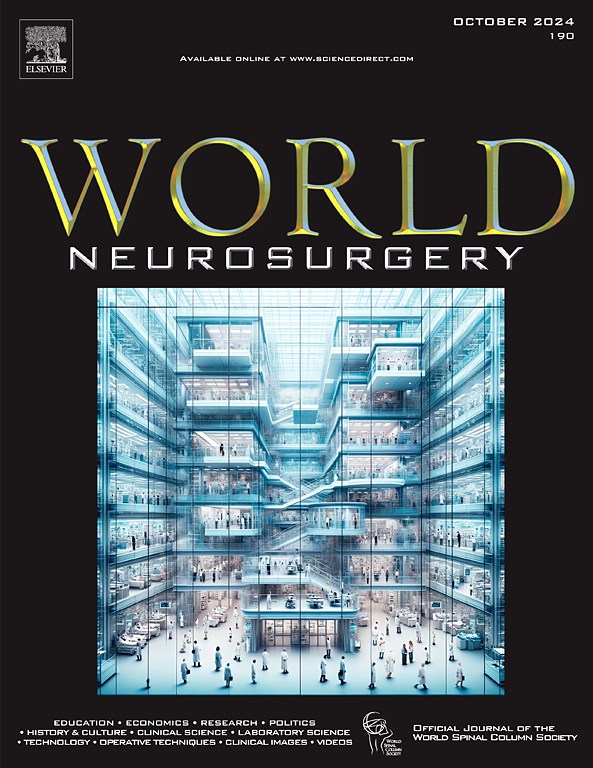New Computed Tomography-Based Classification of Spondylolisthesis due to Pars Defect and Comparison with Meyerding Classification
IF 2.1
4区 医学
Q3 CLINICAL NEUROLOGY
引用次数: 0
Abstract
Objective
We propose a new classification of spondylolisthesis based on the anterior displacement of the defective pars neck relative to the inferior articular process line on parasagittal computed tomography images. We aimed to compare this classification with Meyerding grades (MGs), assess its reliability and applicability, and evaluate its clinical implications.
Methods
A total of 205 lumbar computed tomography images of patients with pars defects and degenerative disc disease were included in the study. According to the algorithm, the pars listhesis grade (PLG) was determined as PLG 0 if the defective pars neck was behind the inferior articular process line, PLG 1 (mild) if it was within the line, PLG 2 (moderate) if it was entirely in front of the line, and PLG 3 (severe) if it was displaced in front of the line with the superior articular process. The rates of bilateral PLG and MG and demographic data were analyzed. Clinical data from 40 patients (10 per PLG grade) were analyzed.
Results
There was a moderate positive correlation between the PLG and MG (r = 0.46) and a strong positive correlation between right and left PLG grades (r = 0.82). Intra- and interobserver reliability showed almost perfect agreement (0.84–0.97). Clinical scores, the visual analog scale, the Oswestry Disability Index, and the SF-36 showed significant differences among PLG levels, with increased disability and decreased physical health observed with higher PLG levels.
Conclusions
PLG classification can be used as a new grading system for spondylolisthesis, especially with low Meyerding grades.
基于ct的峡部缺损椎体滑脱新分类及与Meyerding分类的比较。
目的:基于旁矢状面CT图像上缺损的颈部相对于下关节突(IAP)线的前移位,提出一种新的脊柱滑脱分类方法。我们的目的是将该分级与Meyerding分级(MG)进行比较,评估其可靠性和适用性,并评估其临床意义。方法:对205例伴有部部缺损和退变性椎间盘病变患者的腰椎CT图像进行分析。根据该算法,如果缺陷的部颈部位于IAP线后,则确定其滑脱等级(PLG)为PLG 0,如果位于IAP线内,则确定为PLG 1(轻度),如果完全位于IAP线前,则确定为PLG 2(中度),如果与上关节突移位在IAP线前,则确定为PLG 3(严重)。分析双侧PLG和MG发生率及人口统计学数据。分析了40例患者(每个PLG级别10例)的临床资料。结果:PLG与MG有中度正相关(r = 0.46),右、左PLG分级有强正相关(r = 0.82)。观察者内部和观察者之间的信度几乎完全一致(0.84-0.97)。临床评分、视觉模拟量表、Oswestry残疾指数和SF-36在PLG水平之间存在显著差异,PLG水平越高,残疾程度越高,身体健康状况越差。结论:PLG分级可作为椎体滑脱的一种新的分级系统,尤其适用于Meyerding分级较低的椎体滑脱。
本文章由计算机程序翻译,如有差异,请以英文原文为准。
求助全文
约1分钟内获得全文
求助全文
来源期刊

World neurosurgery
CLINICAL NEUROLOGY-SURGERY
CiteScore
3.90
自引率
15.00%
发文量
1765
审稿时长
47 days
期刊介绍:
World Neurosurgery has an open access mirror journal World Neurosurgery: X, sharing the same aims and scope, editorial team, submission system and rigorous peer review.
The journal''s mission is to:
-To provide a first-class international forum and a 2-way conduit for dialogue that is relevant to neurosurgeons and providers who care for neurosurgery patients. The categories of the exchanged information include clinical and basic science, as well as global information that provide social, political, educational, economic, cultural or societal insights and knowledge that are of significance and relevance to worldwide neurosurgery patient care.
-To act as a primary intellectual catalyst for the stimulation of creativity, the creation of new knowledge, and the enhancement of quality neurosurgical care worldwide.
-To provide a forum for communication that enriches the lives of all neurosurgeons and their colleagues; and, in so doing, enriches the lives of their patients.
Topics to be addressed in World Neurosurgery include: EDUCATION, ECONOMICS, RESEARCH, POLITICS, HISTORY, CULTURE, CLINICAL SCIENCE, LABORATORY SCIENCE, TECHNOLOGY, OPERATIVE TECHNIQUES, CLINICAL IMAGES, VIDEOS
 求助内容:
求助内容: 应助结果提醒方式:
应助结果提醒方式:


